#a.d. 1550
Explore tagged Tumblr posts
Text
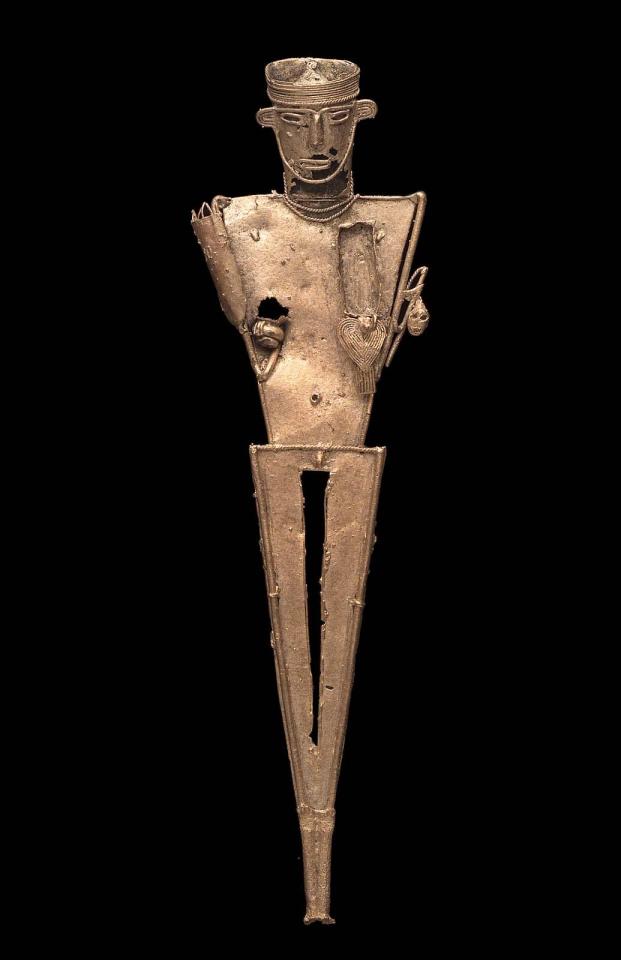
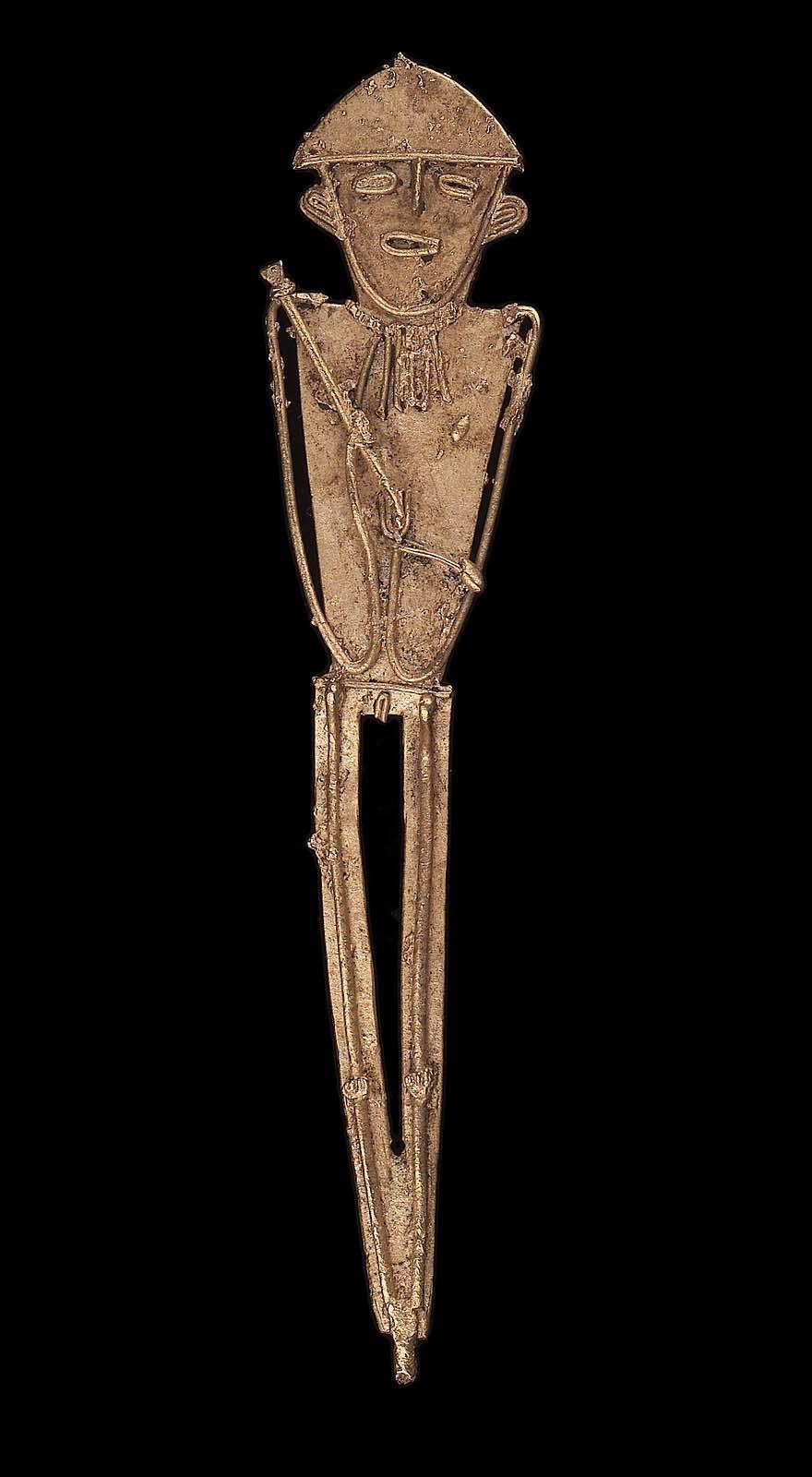
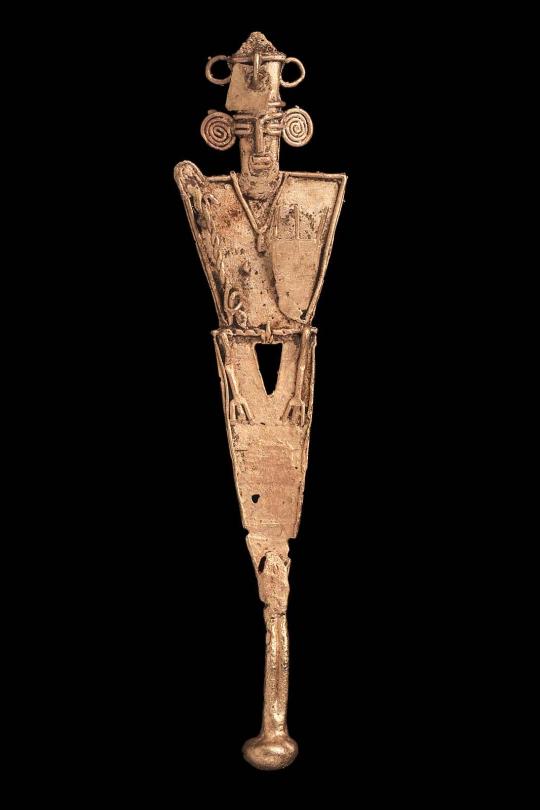
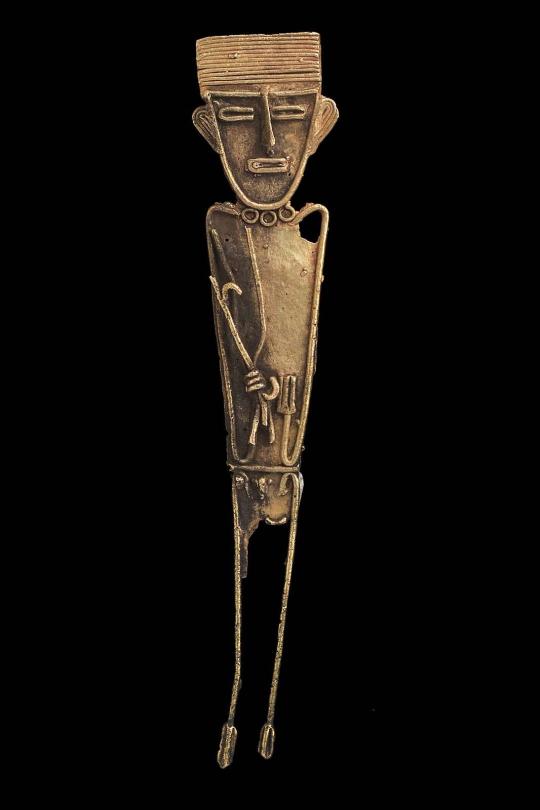
~ Male Effigy Cache Figure.
Culture: Muisca
Date: A.D. 1100–1550
Place of Origin: Departments of Cundinamarca & Boyacá, Colombia
Medium: Gold and copper alloy
#history#museum#archeology#archaeology#12th century#16th century#muisca#colombian#colombia#south america#Cundinamarca#boyaca#male effigy cache figure#male effigy#effigy#a.d. 1100#a.d. 1550
490 notes
·
View notes
Text






























National Shoe The World Day
We celebrate National Shoe The World Day every year on March 15. The day sheds light on the importance of footwear and the need for quality footwear for millions of people worldwide who can’t afford or don’t have access to it. Did you know that nearly one billion people on Earth don’t have shoes, or their footwear is inadequate? Despite difficult terrains and climates, these people walk barefoot or with poor-quality footwear. The good news is that we can all do something about it by donating, sponsoring, or gifting shoes to those who don’t have them.
History of National Shoe The World Day
Food, shelter, and clothes are the basic needs of every human in this world. However, one such necessity that millions of people worldwide struggle to get is good quality footwear. From walking barefoot on hard, warm surfaces to walking in slippery, muddy jungles, many people don’t have access to footwear.
Walking without protection or barefoot can even lead to a lifetime of problems, including pain, injury, cuts, sores, infections, parasites, e.t.c. Moreover, apart from the health issues, people can get banned from schools and other business places for not wearing them, and this issue is exactly what National Shoe The World Day addresses. We might be blessed to have several pairs of shoes in our closets, but few are lucky enough to have one pair of shoes even though they are much too big for them.
National Shoe The World Day was created by the United Indigenous People in Fontana, California, inspired by Donald Zsemonadi in March 2014. Since then, people worldwide have participated in this event and helped ‘shoe’ those struggling without good quality or no footwear. For some of us, shoes might not be such a big thing to talk about and celebrate, but good shoes are still a dream for some in underdeveloped communities. So, let’s raise awareness about the importance of good shoes and act to help those in need.
National Shoe The World Day timeline
1550 B.C.
Areni-1 Shoe
A 5,500-year-old boat-shaped flat open shoe made from leather is found in a cave in Armenia.
476 A.D.
Rise of New Footwear Trends
New shoes of different types and colors begin to appear in Central Europe.
1800s
The Synthetic Method of Coloring
English chemist, William Henry Perkin, invents the first synthetic method of coloring leather and fabric called aniline dyeing to dye shoes.
2014
The Origin of National Shoe The World Day
The United Indigenous people in Fontana create National Shoe The World Day.
National Shoe The World Day FAQs
Why is proper footwear important?
Wearing proper footwear can prevent damage and injury to your feet and protect your feet in the long term.
Can used shoes be donated?
Yes, as long as you ensure that they are in good condition and properly cleaned, you can donate them.
What to do with unwanted shoes?
You can either send them to recycling centers, donate them to a charity shop, or you can even do some crafts on them and re-use them!
How to Observe National Shoe The World Day
Change your footwear: Many health issues could arise from wearing low-quality or no footwear. If you’re dealing with any of those, it's time to change your footwear!
Donate shoes: The best way to celebrate National Shoe The World Day is by donating shoes to those who need footwear in your world.
Share your story: If you’ve seen someone suffer without proper footwear or have personal experience, you can share your story on social media and create awareness.
5 Facts About Footwear We Bet You Didn’t Know
Shoes can be medical: Shoes can help correct posture in diabetic infections and many foot-related problems like Charcot's Foot.
Sneakers are really sneakers: Sneakers got their name because the soles make no sound.
The number is 19: It is estimated that American women own 19 pairs of shoes on average.
$660,000 shoes: The red ruby shoes from the movie, “The Wizard of Oz” sold for $660,000.
Men came first: The first people to wear heels were men in the 10th century.
Why National Shoe The World Day is Important
It is a much-needed initiative: National Shoe The World Day is a meaningful initiative that aims to put shoes on the feet of people who suffer without them.
Shoes are more important than we think: This day reminds us that shoes or any other footwear, in general, are more than just some status symbol; they are essential commodities in today’s world.
People need to know this: It is crucial to raise awareness of how wearing shoes is necessary for people and how not wearing them can cause infections and injuries. National Shoe The World Day helps educate people about this.
Source
#Canada#British Columbia#Alberta#Yukon#National Shoe The World Day#NationalShoeTheWorldDay#15 March#travel#original photography#vacation#tourist attraction#cityscape#landscape#Sonoma#St. Helena#summer 2023#2022#Vancouver#Whitehorse#Skagway#Alaska#Oregon#Washington#California#Utah
3 notes
·
View notes
Text
RANI DURGAVATI // QUEEN OF GONDWANA
“She was the Queen regent of Gondwana in 1550-1564 A.D. She got married to King Dalpat Shah, the son of King Sangram Shah of Gondwana. She served as regent of Gondwana during the minority of her son, Vir Narayan, from 1550 until 1564. She is chiefly remembered for defending Gondwana against the Mughal Empire.”

0 notes
Text

SAINTS NOVEMBER 02 "There is only one tragedy in this life, not to have been a saint."- Leon Bloy
Bl. John Bodey, 1583 A.D. English martyr and schoolmaster. He was born at Wells, Somerset, and educated at Oxford. Converting to the faith, John studied law at Douai in 1557 and returned to England to become a schoolmaster and to marry. When he repudiated King Henry VIII’s claim of supremacy in spiritual matters, he was arrested in 1550. John was imprisoned at Winchester until 1583, when he was taken on November 2 to Andover where he was hanged. He was beatified in 1929.
St. Maura. Maura, the Irish sister of St. Brigid. There legend is that they were Scottish princesses who were murdered by pagan outlaws while on a pilgrimage to Rome. Their bodies are enshrined there. They are believed to be the same St. Maura and St. Britt who were 5th century soldiers per St. Euphronius and St. Martin of Tours. Also there is another legend of them by St. Baya.
0 notes
Text

"Laila and Majnun in School", Folio 129 from a Khamsa (Quintet) of Nizami of Ganja
A.H. 931/A.D. 1524–25
Calligrapher: Sultan Muhammad Nur (Iranian, ca. 1472–ca. 1536)
Calligrapher: Mahmud Muzahib (Iranian, ca. 1500–1560)
Artist: Painting by Shaikh Zada (Iranian, active 1510–1550)
Date: A.H. 931/A.D. 1524–25
Made in present-day Afghanistan, Herat
Medium: Ink, opaque watercolor, and gold on paper
Metropolitan Museum of Art, New York
As featured in The Book of Change (October 2021)
Published in the UK by September Publishing and in the
U.S. by Princeton Architectural Press
"One of the best-known stories of Nizami’s Khamsa (Quintet) is that of Laila and Majnun, a tale akin to that of the star-crossed lovers Romeo and Juliet. This folio illustrates their meeting at the madrasa (school) where they fall in love at first sight. In addition to the young lovers, this highly detailed painting depicts activities typical of the sixteenthcentury schoolyard—with children burnishing paper, practicing their penmanship, and reading various types of books. Although the story takes place in Arabia, the architectural setting is quintessentially Persian." - The Met.
1 note
·
View note
Text
A Land of History
Ka’Lani Clowers
Dr. Harris Cox
English Composition II Section W15
November 10, 2023
A Land of History
By: Ka’Lani Clowers
I finally made it! After driving over an hour, anxiously waiting to reach my destination, I’m here! A land of history; 54 acres of land to the home of several thousand Native Americans from 1000 A.D – 1550 A.D. The scenery of tree leaves dancing in the wind makes a peaceful wind tone; shamrock green grass covers the borrow pits. Further out, following the main sheen green grass path, which is covered with different types of “Native Grasses” such as “Little / Big / Bushy Bluestem”, “Eastern Gamagrass”, “Switchgrass”, and “Indian grass” that lead to one of the main attractions “Mound A - Symbol of a Chiefdom” to my left and the “Plaza for Ceremonies and Games” to my right. Every step I take grasshoppers fly away while blue dragonflies swirl; every step up the steep staircase the wind roars across my ears and hair. Once I reached the top of “Mound A” and did a 360 view, the butterflies in my stomach faded away. Standing on historic land; possibly the land of my previous ancestors, the Etowah Indian Mounds have an extraordinary view of the whole site, and I can’t wait to explore.
Earlier sitting in the shade under a huge tree, I and other volunteers were helping create bee houses and entertaining the children. A staff member of the Etowah Indian Mounds, Ed, offered to give me a mini tour, which is the beginning tour for all tourists, of the first exhibit of “Etowah’s Wattle and Daub House” that once covered the site between 1250 and 1325AD. The name came from the methods and materials where the “wattle” is composed of cane and the “daubed” is a mixture of red clay, water, and grass which allowed the walls to harden (Georgia Public Broadcasting). From the outside of the red-orange square clay wattle and daub House, the small doorway entry made the house look small; however, when entering, the house was very spacious and tall. What amazed me was how the fire smoke rose and left out through the top of the roof and at the same time around the square perimeter clay wall has an opening where it filters fresh air. While exploring the “Wattle and Daub House”, Ed said, “Did you know the women stayed home while the men hunted in the field; the house and land were the women’s property; if the women kicked the man out, he had to leave…” I laughed after hearing the men must leave if the men get kicked out. I told Ed I learned a lot in 25 minutes and, I didn’t know and haven’t realized how much rights and property Etowah Native American women, Creek and Cherokee Indians, processed (Native American). This made me want to look more into the site and do more background research on Native Americans.
Before I knew it, it was lunchtime for all the volunteers. I walked to the picnic area in front of the Etowah Indian Mounds Museum. While waiting in line, I talked with another volunteer named John. We talked about where we’re from and how long we volunteered at this location. I grabbed a hamburger with lettuce, tomato, cheese, onions, and mayo; a hotdog and bun with ketchup; a bag of cheese sun chips; two oatmeal cookies; one red Gatorade, and one fruit punch Capri Sun. While eating my free lunch, I enjoyed the peaceful wind and leaves blowing in the wind. Once I finished my lunch, I got back to Ed to check, and see if there was any other volunteer work for me to do before exploring deep into the Etowah Indian Mounds, and then I set my journey further into the site.
Again, when I arrived at “Mound A”, walking up a quarter-mile-long steep staircase, the muscles in my legs started to weaken; the wind blew hard against my face, and my hair flowed in the wind. The first thought that came to mind when reaching the top was “Woo, that’s a lot of stares... I need a quick break to catch my breath.” My second thought was wow this is a beautiful view. I could see most of the historic site from atop; from cut green grass to about 6 ft tall grass; further out I could see numerous dark green trees; and off into the distance the Allatoona Mountains covered with vegetation. “Mound A”, a “Symbol of a Chiefdom” is where a chief resides with their family on top of the mound that stands about 65 feet tall and was once topped by four buildings with a surrounding courtyard. A chief received the right to rule by birth, ruled until his death, and was represented as both a political and religious leader. While residing on top of “Mound A”, the chief could rule his people, perform religious ceremonies, distribute stored food to his people from public granaries in times of need or famine, and have the power to make war or peace. “Mound A” is across from the Plaza which served as a community gathering place for games and ceremonies (Mark).
Next, I made my way down Mound A and visited other attractions such as the 25-foot-tall “Mound B” which is the site of religious rituals with temples, and the 19-foot-tall “Mound C” which is the burial mound that also had a chapel or temple on top. I continued my journey behind “Mound B” and the left side of “Mound C”, is where the “Etowah River” and the “Etowah River Walk Nature Trail” are located. I’ve completed the “Etowah River Walk Nature Trail” and discovered a lot of plants like Yaupon, and Virginia Creeper, and animals such as Turtles, Bluebird, Great Blue Herons, and Groundhog, that were inhabitants and used in their everyday lives.
Once I’ve completed the “Etowah River Walk Nature Trail” I decided to return to the “Etowah River” because I wanted to explore and find more information. I’m glad I looped back around because I gained knowledge and discovered multiple trees that the “Native Americans” used in their everyday lives like the Black Walnut – for food and bark for toothaches, Bitternut Hickory – Nuts for bread, blowgun darts, and arrow shafts, Cottonwood – a tea for fever and dugout canoes, and more trees.
Later walking along the riverside, I kept stepping on numerous small green circular, what I believe, fruit. The fruit officially grabbed my attention when I heard a loud thump next to me. I thought “Wow, this fruit almost hit me on top of my head!” On the riverside, I ran into Donald Watson who worked at the historic site. Mr. Waston explained to me the hard green circular fruit is a walnut. I said “Wow! Are you serious? Why is the walnut big, green, and hard?” Mr. Waston informed me that walnuts will grow in different stages, and then proceeded to pick up different walnuts off the ground to show me examples of the stages, the walnut is ready to eat once the outer shell is rotten, and how the walnut was one of the main sources of food for the Native Americans.
Afterward, I headed back to the front of the historic site where the “Etowah Museum” is located. I decided to tour the museum, but the exhibit was almost empty due to the artifacts were given back to the Muscogee (Creek) Nation, Thlopthlocco Tribal Town, the Poarch Band of Creek Indians, Alabama-Quassarte Tribal Town, and Kialegee Tribal Town (Etowah Indian Mounds State Historic Site.).
In the end, I was happy to have an authentic souvenir by keeping a fresh walnut that fell off the tree. I made sure I picked up a fresh green walnut so I could watch the different stages of the walnut transformation. My visit was bittersweet because I was very happy to visit, tour, and volunteer; however, I wanted to have a fully guided tour and be able to see all the artifacts from the many Native American tribes. If I’m able to have time in the future, I would love to come back and visit again.
Citations
Etowah Indian Mounds State Historic Site. Etowah Indian Mounds State Historic 4eA#WsAW33wa3w`3WA44Site | Department of Natural Resources Division. (n.d.). https://gastateparks.org/EtowahIndianMounds
“American Indian Culture at Etowah - Google Arts & Culture.” Google, Google, artsandculture.google.com/story/american-indian-culture-at-etowah-georgia-public-broadcasting/qwVx2UuydyoTIw?hl=en. Accessed 1 Nov. 2023.
“Native American.” The Etowah Valley Historical Society of Bartow County, Georgia, Etowah Valley Historical Society, evhsonline.org/native-american. Accessed 1 Nov. 2023.
Rebecca. “Etowah Indian Mounds Historic Site: Know Before You Go.” Day Trip Queen, 5 Sept. 2022, daytripqueen.com/etowah-indian-mounds/.
Mark, Joshua J.. "Etowah Mounds." World History Encyclopedia. World History Encyclopedia, 10 May 2021. Web. 08 Nov 2023.
0 notes
Text


When did the Moors travel to the Americas, and is there evidence that they actually did reach the Americas?
Yes, they did reach the Americans. There is evidence.But who were the Moors?Ignoring the etymology of the word moor makes history illiterate.Origin and meaning of moor by Online Etymology DictionaryMoor (n.)"North African, Berber," late 14c., from http://O.Fr. More, from M.L. Morus, from L. Maurus "inhabitant of Mauritania" (northwest Africa, a region now corresponding to northern Algeria and Morocco), from Gk. Mauros, perhaps a native name, or else cognate with mauros "black".Being a dark people in relation to Europeans, their name in the Middle Ages was a synonym for negro;"In the etymological dictionary of the French language by” Gilles "Ménage" (xvii century) More is defined as black or blackish man.About the Moors of Spain we read in the same dictionary, we have called Moors or Moorish Arabs who conquered Spain because they came from Mauritania, that is to say the land of black or blackish menOrigins of the Picts and ScotsThe Moors have bodies black as night, while the skin of the Gauls is white.Strabo: Geography, c. 22 A.D., XVII.iii.1-11And I have heard this man say that beyond the country which he ruled there was no habitation of men, but desert land extending to a great distance, and that beyond that there are men, not black-skinned like the Mauretanii.6th A.D. – Procopius in his History of the Wars book IV contrasting the Germanic Vandals who had settled in North Africa with the Moors claimed the Vandals were not “black skinned like the Maurusioi”Travels of Sir John MandevilleSir Jean Mandeville, wrote that: "and men of Nubia be Christian, but they be black as the Moors for great heat of the sunThe word Moor predates Islam. Washing the Moor white is a very old European saying derived from an Aesop’s fable. It means you are wasting your time. A Moor will always be black. Aesop lived in classical Greece.http://intl-nq.oxfordjournals.org/content/60/4/547 (http://intl-nq.oxfordjournals.org/content/60/4/547)Washing the Moor White on the Early Modern English Stage (1550–1666): five undetected casesTHE presence of the motif of washing a Moor white is notably recurrent in all sort of texts in the Western and, particularly, English iconic and literary tradition.This motif is usually presented in association with negative connotations and the misrepresentation of the physical characteristics, customs, and conduct of black people with the aim of asserting white superiority.http://ww.sefone.soton.ac.uk/.../African%20Diaspora%20-%20Bayreuth_Cyp...%E2%80%8EThere is even a city in Germany called Bayreuth whose inhabitants are called the Moor washers following a racist incident who lead to the death of the Black man they tried to wash White.Bayreuther Folklore“Mohrenwäscher” and “MohrenlandAccording to Bayreuther folklore, an African male “Mohr” was exhibited during the mid-1800s in the city of Bayreuth.Rumor had it that the man was not really Black, but merely a white person appearing in “Black face”.After nearly scrubbing and soaping the African man to death in the “Roter Main” river, those that doubted the authenticity of the man’s Blackness, came to the conclusion that the man was indeed a “Mohr” (Black).Thus, the citizens of Bayreuth have come to be known as the “Mohrenwäscher” and the particular spot where the incident occurred “Mohrenland”.Mauretania (Mauritania)Mauretania, or Maurusia, as it was called by Greek writers, unquestionably signified the land of the Mauri, a term still retained in the modern name of Moors, and probably meaning originally nothing but black menNot all Moors were Muslims. The word Moor was applied to people who were African Christians, including African saints. Victor Maurus - WikipediaVictor the Moor (in Latin: Victor Maurus) (born 3rd century in Mauretania; died ca. 303 in Milan) was a native of Mauretania and a Christian martyr, according to tradition, and is venerated as a saint. Victor, born into a Christian family, was a soldier in the Roman Praetorian Guard. After he had destroyed some pagan altars, he was arrested, tortured, and killed around 303.Zeno of Verona - WikipediaAccording to
a Veronese author named Coronato, a notary of the 7th century, Zeno was a native of Mauretania. He taught many children of Africa about the Catholic religion and he also helped them with their school work. The children could rely on someone who could help them[1] Another theory is that Zeno was a follower of Athanasius, patriarch of Alexandria, who accompanied his master when the latter visited Verona in 340.Benedict the Moor - WikipediaBenedict the Moor, O.F.M., (Italian: Benedetto da San Fratello, 1526 – April 4, 1589) was an Italian Franciscan friar in Sicily who is venerated as a saint in the Catholic and Lutheran churches.Born of African slaves in San Fratello, he was freed at birth and became known for his charity. As a young man he joined a Franciscan-affiliated hermit group, of which he became the leader. In 1564 he was sent to the Franciscan friary in Palermo, where he continued good works.…Here are books that indicate that Moors /Berbers were in America.Amazigh In America Before Columbus | Amazigh World NewsJugurtha Bibliothèque en ligne
#amazigh#african#afrakan#kemetic dreams#brownskin#afrakan spirituality#african culture#afrakan woman#africans#afrakans#america#christopher columbus#moors#berbers#italian#catholic#lutheran#strabo#geography#english#north africa#marutina
110 notes
·
View notes
Text
European Tapestry Production and Patronage 1400–1600
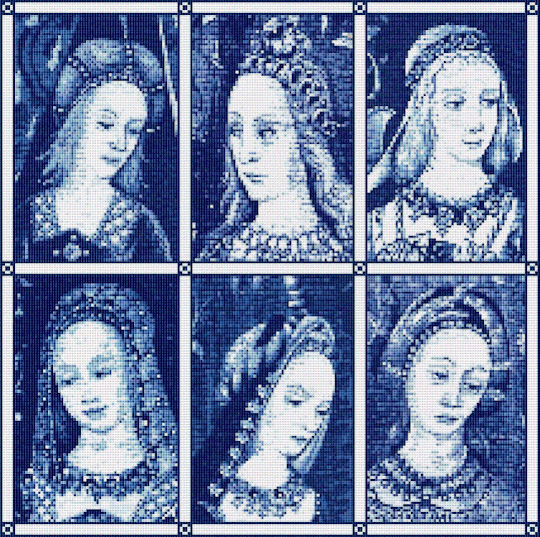
wealthy patrons could commission designs whose subjects embodied celebratory or propagandistic themes. Enriched with silk and gilt metallic thread, such tapestries were a central component of the ostentatious magnificence used by powerful secular and religious rulers to broadcast their wealth and might
from early 14th century A.C an industry capable of producing high quality large tapestries took roots in northern france and southern Netherlands (Belgium)
This development was stimulated by:
the availability of skilled weavers and dyers
by the existence of local guilds that supported and encouraged the development of this nascent industry
by the commissions of local patrons
By the mid-fifteenth century, (1450 A.D) numerous tapestry workshops existed in the low countries in towns such as:
Arras

Tournai
Lille
Brussels

From these centers, tapestries were exported throughout Europe
During the last quarter of the 1475 d.C high-quality Netherlandish production was increasingly dominated by the workshops in Brussels.
This was the result of three factors:
the decline of the industry in Arras and Tournai;
the emergence of Brussels as the principal seat of the Burgundian court in the Netherlands
the monopoly that the Brussels artists’ Guild of Saint Luke secured in 1476 over the fabrication of figurative tapestry cartoons

The Battle with the Sagittary and the Conference at Achilles' Tent (from Scenes from the Story of the Trojan War) ca. 1470–90
The conservative tendency to make extremely rich in details tapestries was challenged by a set of ten tapestries traditionally known as the Acts of the Apostles (1516–21) that was commissioned by Papa leone X in 1515 designed by raffaello sanzio

The first Netherlandish painter whose tapestry designs reflect an informed response to the aesthetics of the Italian Renaissance was Bernaert van Orley, during the 1520s
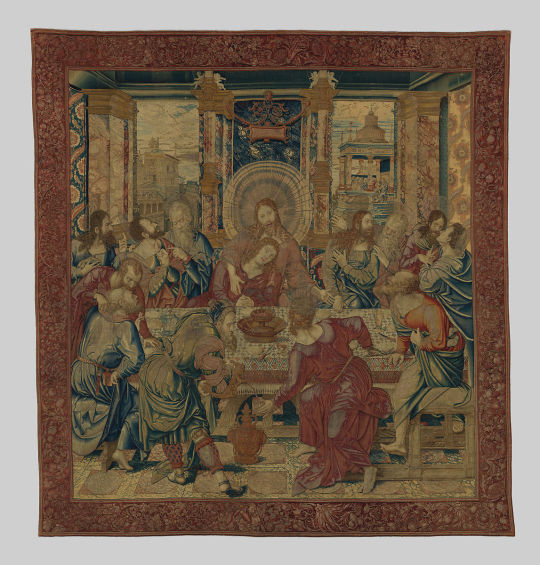
The Last Supper ca. 1525–28- Bernaert Van Orley
He forged a style that combined elements of the Netherlandish tradition, such as:
multiple narrative and complex anecdotal, decorative, and landscape detail (attention to details)
with the italian traditions
the visualization of each scene as a realistic presentation of a moment of physical or emotional drama embodied by lifesize figures acting in clearly defined perspectival settings
During the second quarter of the sixteenth century,(1525-1550 A.D) we find technical and artistic achievements. A number of smaller enterprises were set up elsewhere in Europe.

The Unicorn Rests in a Garden (from the Unicorn Tapestries)1495–1505
🇮🇹 In Italy:
there were workshops established by Ercole II d’Este in Ferrara in 1536 where designs by dosso dossi and Giulio Romano, among others, were produced.
In 1539, a workshop was also established in Mantova by Federigo Gonzaga
A number of the weavers involved in these workshops subsequently relocated to Florence when Cosimo I de' Medici established two workshops in 1545.
Although the workshops in Mantua and Ferrara were defunct by, respectively, 1563 and 1582, the Florence workshops continued
The Decline
Religious persecution had cast its shadow over the Netherlandish industry from the late 1520s
During the 1530s and 1540s, increasing numbers of Flemish weavers relocated to towns in the Germanic states that were more tolerant of their beliefs
The number of migrants was to increase dramatically during the late 1560s as Philip II of Spain sought to repress the reform movement in the Netherlands.
With the arrival of the Duke of Alba and his army in 1568 and the institution of the Council of Troubles, this exodus turned into a flood as weavers migration emigrated to more tolerant regions in the northern Netherlands (Holland), the Germanic states, France, and England
Although production did continue during the late sixteenth century, the tapestries made during this era are of much lower quality
new centers of importance emerged in:
Delft
Paris
Munich
Flemish weavers were eventually lured across Europe, and this transfer of skill led to the success of the Gobelins factory in Paris that finally stole Flanders’s crown in the late 1700s
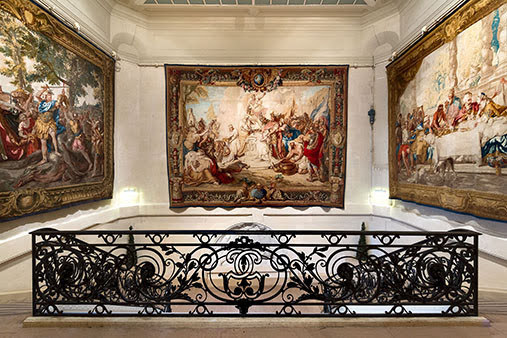

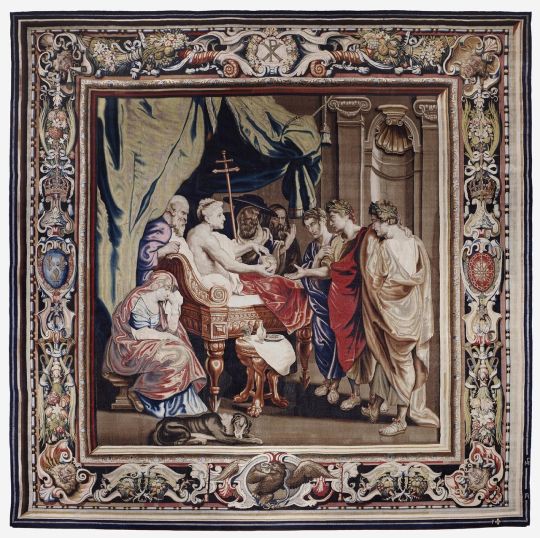
#dutch#tapestry#middle ages#medieval art#italian renaissance#renaissance art#renaissance aesthetic#renaissance#belgian art#belgium#netherlands#dutch langblr#studyblr#dark academia#academia aesthetic#study notes#metmuseum#dutch language#medievalart#brussels#delft#tournai
83 notes
·
View notes
Photo

Tripod Rattle Bowl
A.D. 1200-1550
Purepecha
Michoacán, Mexico
Provenience unknown, possibly looted
The Tarascan people of Michoacan were politically united under the authority of a king whose capital was the city of Tzintzuntzan, near Lake Pátzcuaro. Tarascan kings also served as effective war leaders, successfully resisting Aztec assaults and maintaining their people’s independence until the Spanish conquest.
Tzintzuntzan’s most impressive architectural monument is a huge, stone faced platform topped by five stepped pyramids called “yákatas.” Tombs with rich offerings interred in the yákatas probably held the remains of Tarascan kings or nobles. Tarascan craftsmen produced sophisticated tools and ornaments in obsidian, gold, copper, shell, and turquoise. They also manufactured highly distinctive ceramic forms with painted and smoke-decorated surfaces. This bowl features large, swollen hollow legs containing pellets that rattle when it is moved. Its surface was coated with a pale slip and burnished before firing. After cooling, a pattern was painted on using liquid clay or some other soluble material. The vessel was then smoked over a fire to darken the unprotected surfaces. When the resist material was washed off, the boldly contrasting pattern was revealed.
DAM
110 notes
·
View notes
Text

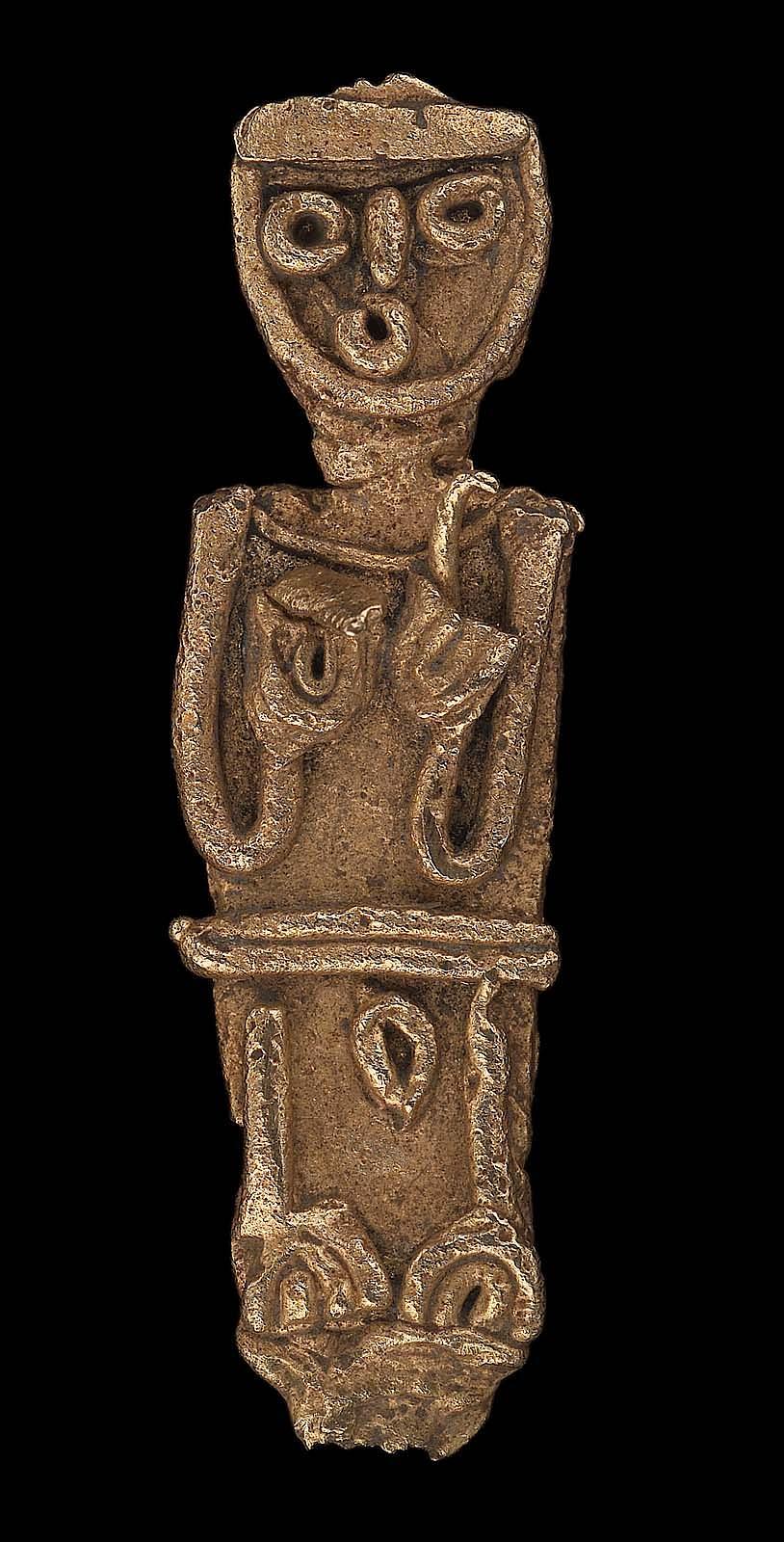

~ Female effigy cache figure.
Culture: Muisca
Date: A.D. 1100–1550
Place of Origin: Departments of Cundinamarca & Boyacá, Colombia
Medium: Gold and copper alloy
#history#museum#archeology#archaeology#12th century#16th century#female#female effigy cache figure#effigy#latin america#latinoamerica#colombia#gold#muisca#a.d. 1100#a.d. 1550
484 notes
·
View notes
Photo

Augsburger Wunderzeichenbuch, Folio 28 (wunderbarlicher Comet, 1007 über Deutschland und dem Welschland) Folio 34: "In 1007 A.D., a wondrous comet appeared. It gave off fire and flames in every direction. It was seen in Germany and Welschland and it fell onto the earth." Augsburger Wunderzeichenbuch, c. 1550
47 notes
·
View notes
Text



























National Shoe The World Day
We celebrate National Shoe The World Day every year on March 15. The day sheds light on the importance of footwear and the need for quality footwear for millions of people worldwide who can’t afford or don’t have access to it. Did you know that nearly one billion people on Earth don’t have shoes, or their footwear is inadequate? Despite difficult terrains and climates, these people walk barefoot or with poor-quality footwear. The good news is that we can all do something about it by donating, sponsoring, or gifting shoes to those who don’t have them.
History of National Shoe The World Day
Food, shelter, and clothes are the basic needs of every human in this world. However, one such necessity that millions of people worldwide struggle to get is good quality footwear. From walking barefoot on hard, warm surfaces to walking in slippery, muddy jungles, many people don’t have access to footwear.
Walking without protection or barefoot can even lead to a lifetime of problems, including pain, injury, cuts, sores, infections, parasites, e.t.c. Moreover, apart from the health issues, people can get banned from schools and other business places for not wearing them, and this issue is exactly what National Shoe The World Day addresses. We might be blessed to have several pairs of shoes in our closets, but few are lucky enough to have one pair of shoes even though they are much too big for them.
National Shoe The World Day was created by the United Indigenous People in Fontana, California, inspired by Donald Zsemonadi in March 2014. Since then, people worldwide have participated in this event and helped ‘shoe’ those struggling without good quality or no footwear. For some of us, shoes might not be such a big thing to talk about and celebrate, but good shoes are still a dream for some in underdeveloped communities. So, let’s raise awareness about the importance of good shoes and act to help those in need.
National Shoe The World Day timeline
1550 B.C.
Areni-1 Shoe
A 5,500-year-old boat-shaped flat open shoe made from leather is found in a cave in Armenia.
476 A.D.
Rise of New Footwear Trends
New shoes of different types and colors begin to appear in Central Europe.
1800s
The Synthetic Method of Coloring
English chemist, William Henry Perkin, invents the first synthetic method of coloring leather and fabric called aniline dyeing to dye shoes.
2014
The Origin of National Shoe The World Day
The United Indigenous people in Fontana create National Shoe The World Day.
National Shoe The World Day FAQs
Why is proper footwear important?
Wearing proper footwear can prevent damage and injury to your feet and protect your feet in the long term.
Can used shoes be donated?
Yes, as long as you ensure that they are in good condition and properly cleaned, you can donate them.
What to do with unwanted shoes?
You can either send them to recycling centers, donate them to a charity shop, or you can even do some crafts on them and re-use them!
How to Observe National Shoe The World Day
Change your footwear: Many health issues could arise from wearing low-quality or no footwear. If you’re dealing with any of those, it's time to change your footwear!
Donate shoes: The best way to celebrate National Shoe The World Day is by donating shoes to those who need footwear in your world.
Share your story: If you’ve seen someone suffer without proper footwear or have personal experience, you can share your story on social media and create awareness.
5 Facts About Footwear We Bet You Didn’t Know
Shoes can be medical: Shoes can help correct posture in diabetic infections and many foot-related problems like Charcot's Foot.
Sneakers are really sneakers: Sneakers got their name because the soles make no sound.
The number is 19: It is estimated that American women own 19 pairs of shoes on average.
$660,000 shoes: The red ruby shoes from the movie, “The Wizard of Oz” sold for $660,000.
Men came first: The first people to wear heels were men in the 10th century.
Why National Shoe The World Day is Important
It is a much-needed initiative: National Shoe The World Day is a meaningful initiative that aims to put shoes on the feet of people who suffer without them.
Shoes are more important than we think: This day reminds us that shoes or any other footwear, in general, are more than just some status symbol; they are essential commodities in today’s world.
People need to know this: It is crucial to raise awareness of how wearing shoes is necessary for people and how not wearing them can cause infections and injuries. National Shoe The World Day helps educate people about this.
Source
#Canada#British Columbia#Alberta#National Shoe The World Day#NationalShoeTheWorldDay#15 March#travel#original photography#vacation#tourist attraction#cityscape#landscape#Northwest Territories#USA#summer 2023#Oregon#California#Calgary#Yellowknife#Napa Valley#Yellowstone National Park#Banff National Park#Glacier National Park#Idaho Falls#Wyoming#Montana#Nevada
1 note
·
View note
Text
The Image of Hercules with infant Telephos
The statue of Heracles with infant Telephos which is located in the Chiaramonti Museum is the oldest example of this image, having been created in the 2nd century A.D. as a copy of a Greek statue of the 4th century A.D.

This statue, which was discovered in Rome in the vicinity of Campo de’ Fiori, was one of the first sculptures to come into the Vatican collections. Pope Julius II (1503-1573) exhibited it in the Courtyard of the Statues in the Belvedere. The presence of Heracles, in fact, leads us back to the mythological origins of Rome and alludes in particular to the victory of the Romans over the tribes of ancient Latium. The god Heracles, with his club and lion skin, holds his son Telephos in his arms. Telephos is the son born to Heracles by the priestess Auge who was forced to abandon the child in the mountains of Arcadia, where he was nourished by a doe until he was rescued by his father. Telephos became King of Mysia and one of the leading characters in a rich and complex mythology that sees him involved in the Greek expedition against Troy. This statue is a second century A.D. copy, probably of a Late Hellenistic original.

In The Poison King: The Life and Legend of Mithradates: Rome's Deadliest Enemy, Adrienne Mayor states that "Recent analysis of portraiture in contemporary coins and sculpture suggests that the model for the little boy was none other than Mithradates!"
According to her Pompey the Great recognized the likeness of the baby Telephus to Mithradates and took it to Rome after defeating Mithradates in 63 BC (Mayor): "Pompey installed this Hercules statue in his Theater on the Field of Mars in Rome. The statue was discovered in 1507 in Campo dei Fiori, near the ruins of Pompey's Theater."

After its rediscovery in 1507, the statue became an inspiration for the artists of its time leading to many engravings of the image belonging to the 16th century. The emperor Commodus was pictured in the same pose multiple times in the Speculum Romanae Magnificentiae (published c. 1540-80), inspiring slightly different copies which dates extend into the 18th century. I am not sure if I have acquired all of these copies since there are so many. But here are some;

Emperor Commodus as Hercules, Attributed to Jacob(us) Bos, 1550
This print comes from the museum’s copy of the Speculum Romanae Magnificentiae (The Mirror of Roman Magnificence) The Speculum found its origin in the publishing endeavors of Antonio Salamanca and Antonio Lafreri. During their Roman publishing careers, the two foreign publishers - who worked together between 1553 and 1563 - initiated the production of prints recording art works, architecture and city views related to Antique and Modern Rome. The prints could be bought individually by tourists and collectors, but were also purchased in larger groups which were often bound together in an album. In 1573, Lafreri commissioned a title page for this purpose, which is where the title ‘Speculum Romanae Magnificentiae’ first appears. Lafreri envisioned an ideal arrangement of the prints in 7 different categories, but during his lifetime, never appears to have offered one standard, bound set of prints. Instead, clients composed their own selection from the corpus to be bound, or collected a group of prints over time. When Lafreri died, two-third of the existing copper plates went to the Duchetti family (Claudio and Stefano), while another third was distributed among several publishers. The Duchetti appear to have standardized production, offering a more or less uniform version of the Speculum to their clients. The popularity of the prints also inspired other publishers in Rome to make copies however, and to add new prints to the corpus.

The Emperor Commodus dressed as Hercules, after an antique statue placed in a niche in the Belvedere, Anonymous, 1587-89

Hercules and Telephos, Hendrick Glotzius, c. 1592
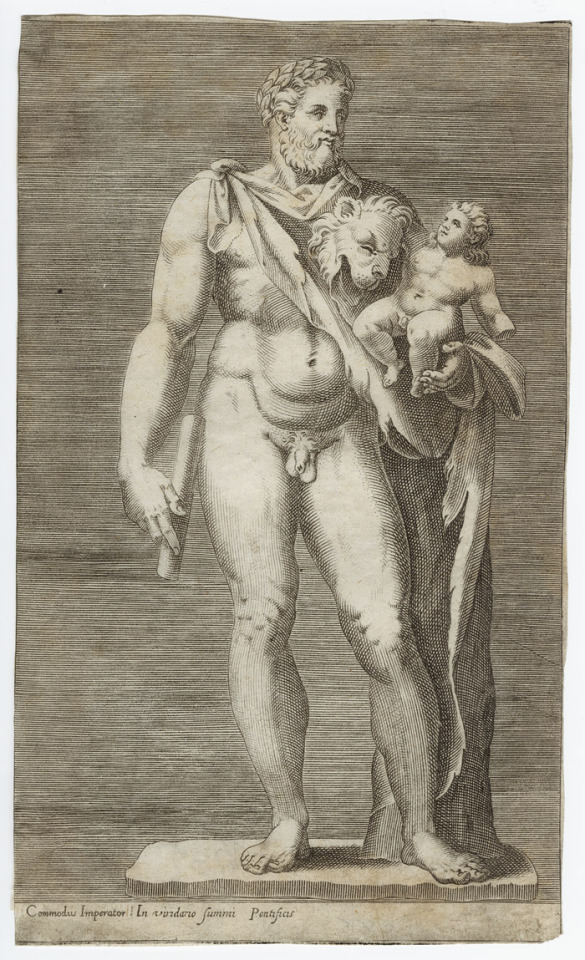
Emperor Commodus in the Papal gardens, after the engraving of Jacob(us) Bos, ca. 1614
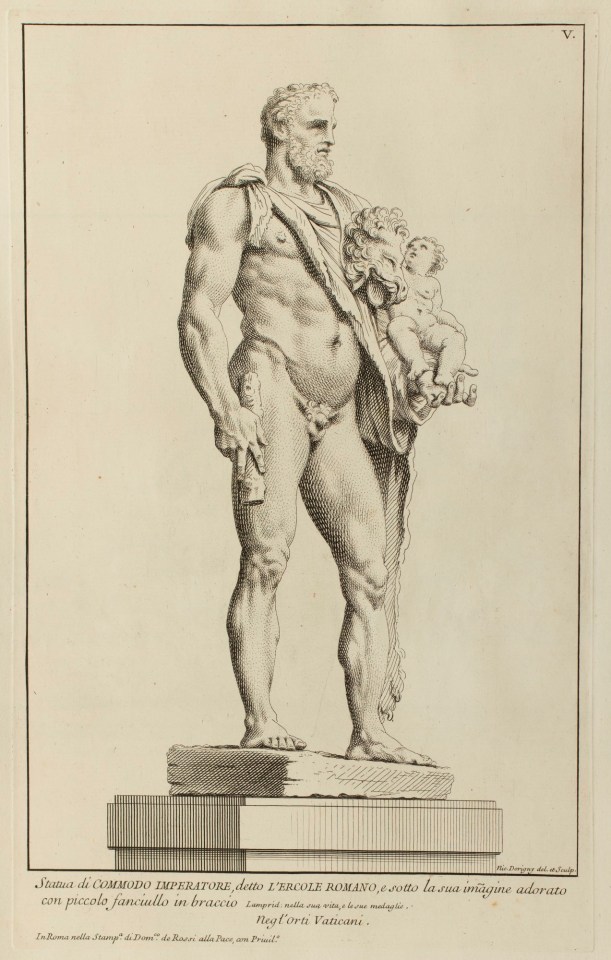
Heracles with infant Telephos, Sir Nicolas Dorigny, 1704
Of course, the statue’s artistic interpretations were not limited to engravings. Here is a terracotta reproduction by Stefano Maderno, dated 1620.

And lastly, I would like to add a very interesting photograph by James Anderson dating 1859 and bearing the name Hercule avec le jeune Ajax. It is a photograph of the sculpture we know today but with the father's genitals covered and the club still intact.
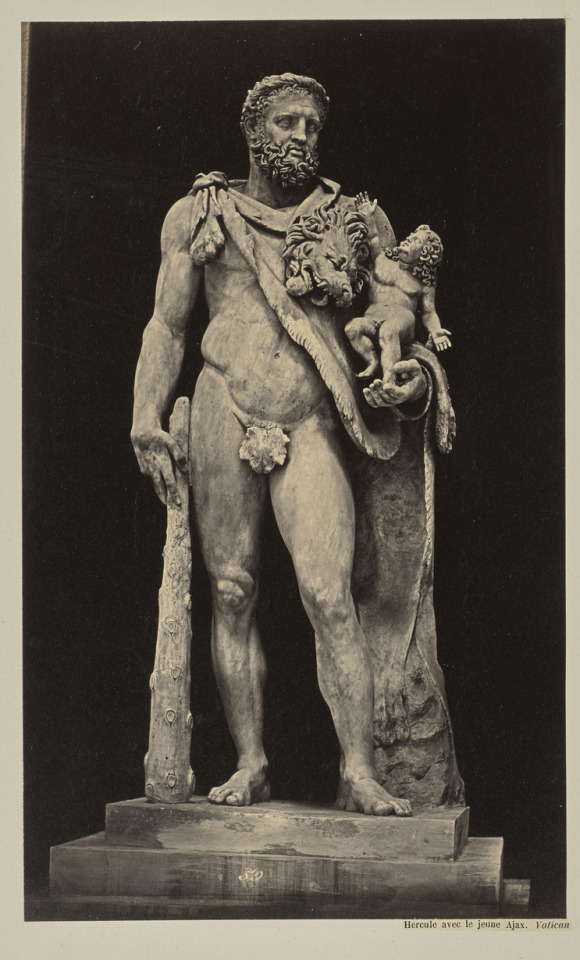
Image Sources:
1. http://www.museivaticani.va/content/museivaticani/en/collezioni/musei/museo-chiaramonti/ercole-e-telefo-bambino.html
2. https://www.flickr.com/photos/askrobotov/48448640202/
3. https://www.flickr.com/photos/hen-magonza/7361370584/
4. https://www.metmuseum.org/art/collection/search/402935
5. https://www.britishmuseum.org/research/collection_online/collection_object_details.aspx?assetId=340981001&objectId=3064979&partId=1
6. https://www.artic.edu/artworks/112044/hercules-and-telephos-plate-two-from-three-famous-antique-sculptures
7. http://speculum.lib.uchicago.edu/search.php?search%5B0%5D=commodus&searchnode%5B0%5D=all&result=7
8. https://www.royalacademy.org.uk/art-artists/work-of-art/heracles-with-infant-telephos-kown-as-commodo-imperatore-or-ercole-romano
9. shorturl.at/fgDJ9
10. http://www.getty.edu/art/collection/objects/218216/james-anderson-hercule-avec-le-jeune-ajax-vatican-british-1859/?dz=0.4745,0.4745,0.74
#greek art#roman art#hellenistic#hercules#herakles#telephos#herakles and telephos#vatican#musei vaticani#vatican museums#sculpture
66 notes
·
View notes
Text

Saint of the day July 14
Bl. Richard Langhorne, 1679 A.D. English martyr. Born in Bedfordshire, he was educated at the Inner Temple and worked as a lawyer. He was arrested in 1667, released in 1679, and then arrested again as a conspirator in the so-called “Popish Plot.” He was hanged at Tybum on July 14. Richard was beatified in 1929. https://en.wikipedia.org/wiki/Richard_Langhorne https://soul-candy.info/category/saints/page/10/
Blessed Kateri Tekakwitha, 1680 A.D. Patron of the environment and ecology. Kateri was born near the town of Auriesville, New York, in the year 1656, the daughter of a Mohawk warrior. She was four years old when her mother died of smallpox. The disease also attacked Kateri and transfigured her face. She was adopted by her two aunts and an uncle. Kateri became converted as a teenager. She was baptized at the age of twenty and incurred the great hostility of her tribe. Although she had to suffer greatly for her Faith, she remained firm in it. Kateri went to the new Christian colony of Indians in Canada. Here she lived a life dedicated to prayer, penitential practices, and care for the sick and aged. Every morning, even in bitterest winter, she stood before the chapel door until it opened at four and remained there until after the last Mass. She was devoted to the Eucharist and to Jesus Crucified. She died on April 7, 1680 at the age of twenty-four. She is known as the "Lily of the Mohawks". Devotion to Kateri is responsible for establishing Native American ministries in Catholic Churches all over the United States and Canada. Kateri was declared venerable by the Catholic Church in 1943 and she was Beatified in 1980. Work is currently underway to have her Canonized by the Church. Hundreds of thousands have visited shrines to Kateri erected at both St. Francis Xavier and Caughnawaga and at her birth place at Auriesville, New York. Pilgrimages at these sites continue today. Bl. Kateri Teckakwitha is the first Native American to be declared a Blessed. https://www.kateri.org/our-patron-saint/
Saint Camillus-Patron of nurses and the sick. Born in Naples in 1550, St Camillus was very tall, (six foot six) and, as a young man, hot-tempered and a wild gambler. He spent some time in the Venetian army fighting the Turks before contracting a disease which left him lame in one leg. He then lost everything through gambling. For a few months he worked as labourer for the Franciscans. During this time, he experienced a change of heart and tried to join the order, but his health prevented this. Instead he offered himself to the hospital of San Giacomo in Rome. In time he became bursar there.
Later, on the advice of St Philip Neri, Camillus offered himself for the priesthood. He was ordained on Pentecost of 1584 by Lord Thomas Goldwell, Bishop of St Asaph, Wales, (and the last surviving Catholic bishop of Great Britain.) Camillus then retired from his service at the hospital, and he and some companions moved to the Hospital of the Holy Ghost, where they assumed responsibility for the care of the patients there. His nursing order later became known as the Camillians. Members of the Order devoted themselves to victims of Bubonic plague, in their homes, in hospitals and prisons. Some rowed out to look after galley slaves on war ships, others went to the battlefields of Hungary and Croatia, setting up the first recorded 'military ambulance unit'. The large, red cross on their cassock remains a symbol of the Congregation today. This was the original Red Cross, hundreds of years before the International Red Cross Organization was formed. St Camillus was a pioneer in insisting on fresh air, suitable diets and the isolation of patients with contagious diseases. He set up 15 houses and eight hospitals working in them personally himself. He suffered a number of serious illnesses himself, but continued working almost until the day he died, in Genoa in 1614. He was canonised in 1746. Read more about the Camillians here: http://www.camillians.org/ https://en.wikipedia.org/wiki/Camillus_de_Lellis
1 note
·
View note
Photo

Tiber River Monster, inspired by Folio 90 of the Wunderzeichenbuch (Book of Miracles), Augsburg, circa 1550
“In A.D. 1496, in the month of January, at the time The Tiber burst its banks high and wide near Rome: what wondrous creature appeared, found dead where the raging and the might of the Tiber's waters had subsided, and was in this shape and form, as it is painted there.”
#miracle#wunderzeichenbuch#augsburg book of miracles#2019 advent ficlet challenge#it differs significantly from folio 90 in that one leg is a bird leg and i didn't draw the other arm which ended in a horse hoof#also scales over the arms and legs#artists on tumblr#sketch daily
2 notes
·
View notes
Photo

Folio 171: "In A.D. 1552, on May 17, such a terrible storm with hail descended on Dordrecht in Holland, that the people thought the Day of Judgement was coming. And it lasted about half an hour. Several of the stones weighed up to a few pounds and 8 lot. And where they fell, they gave a frightful stench." Augsburger Wunderzeichenbuch, c. 1550
Found via https://www.instagram.com/subterraneanthunder/
3 notes
·
View notes